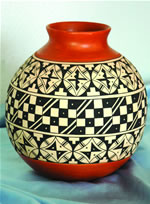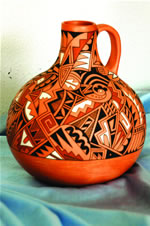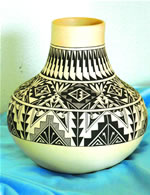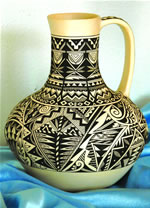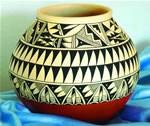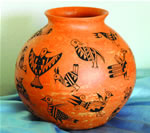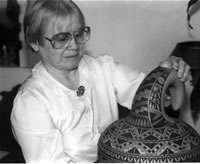 Reyes Madalena
Reyes Madalena |
Why do some people have a gift? Why
can some people create music out of metal, or art out of
pigment, or pots out of clay? Why are some people sublimely
talented while others struggle in the same area?
It seems to be a randomness of genetics. Yes, some families
appear to carry an art gene that gets passed down from
one generation to the next, but even within those families,
why does one sibling get it and not the others. It seems
to be as random as the passing on of a recessive gene that
pops up from time to time, causing relations to exclaim, “why
the baby is a carbon copy of Great Aunt So-and-So!”
After all, isn’t that the basic explanation of how
you would end up with a naturally sunlight-blonde Native
American.
When Reyes Madalena, a Jemez (pronounced “Hay-miss”)
Reservation Pueblo, laughed on the phone while telling me
she was blonde, I wasn’t sure who the joke was on.
Apparently it’s no joke. She’s a hundred percent
indigenous to this land, and she’s blonder than most
of us (including our artificial highlights). She’s
just got light pigmentation, one of those random blips in
a family gene pool that surfaces unexpectedly.
This unusual coloring considering her ethnicity is not the
only thing that connects her to the rich tapestry of her
ancestry. Another thread that reappeared in Madalena was
her grandmother’s talent with clay. Madalena is a potter.
Now, when I say “potter,” I don’t mean
someone who buys clay, throws it on a wheel and paints it
with glazes, which is no small feat to begin with. Ask anyone
who’s tried, and, most likely, struggled.
No, I mean “potter” in the sense that her ability
to craft clay into art is written into her DNA, much like
her gender, height and skin color are. She inherited this
gift. It literally emanates from her fingertips.
As we talked, she maintained eye contact with me the entire
time she manipulated a ball of clay around and around in
her hands until a well-shaped, symmetrical bowl emerged.
She never had to look at what she was doing. She created
out of touch, not sight.
This connection Madalena has with the earth (after all, that’s
what clay is) and her art is part of what makes her pottery
so magic.
You could identify the physical reasons why her earthenware
is so smooth, resists cracking and burnishes to such a splendid
sheen. Pottery, in its essence, is chemistry in action. And,
like any good cook, a good potter needs to know how the clays
will react, particularly under the intense heat of a firing.
But, analyzing the chemistry of pottery is like analyzing
the chemistry of a person; it may explain their unusual pigmentation,
for example, but it doesn’t capture how that color
has shaped the person.
In Madalena’s case, growing up on one of the few continuously
inhabited pueblos, her singular look galvanized her to embrace
her heritage more fervently than the others.
Born in the late 1930’s, she grew up with the other
Reservation kids calling her “white girl,” which
made her dream “that someday I’m going to do
something really Indian,” she recounts.
And, sure enough, she’s the only one of her childhood
friends who became such an accomplished potter.
To be fair, Madalena had the advantage of genetics on her
side. Her maternal grandmother, Benina Medina Madalena from
the Zia Reservation, had been an excellent potter, winning
awards in the early 1920’s at the Santa Fe Indian Market.
She was the one who essentially reintroduced the art to the
Jemez Reservation, where the craftsmen had focused on other
indigenous crafts.
Benina taught her daughters pottery which created a wonderful
beginning for Madalena, who remembers watching and listening
to her mother and aunt making pots. Although they were accomplished,
the natural talent Benina possessed resurfaced in Madalena,
who uses the same techniques, the same clay sources and the
same smooth red jasper stone to burnish her pots to a high
sheen.
The inheritance of this particular river stone symbolizes
the passing on of the knowledge and gift for pottery-making,
from grandmother to grand-daughter.
Madalena, whose sensitive skin doesn’t tolerate synthetic
materials, uses all natural clays and slips. She and her
immediate family mine the rock clay themselves, which includes
hauling out 100-pound packs on foot over rough trails. One
of her greatest moments was discovering the seam of gray
clay found in the Four Corners area that yields the fine
white pottery which much of her current work is made of.
For decades, she searched for its origins. Most clay fires
up a reddish or brownish color, so this white clay that her
ancestors used was a momentous discovery. Because of this
clay’s purity, Madalena is fairly sure that she’s
mining the same seam as her ancestors, and this connection
excites her.
She also feels connected to the past by using traditional
methods. She processes the clay herself, aided by her husband.
After soaking the rock for several weeks to soften it, she
mixes it and, then, allows it to evaporate in burlap bags
until it arrives at the desired consistency.
She shapes the pot either by pinching the clay while rotating
it methodically (called a “pinch pot”) or roping
long coils of clay on top of one another and smoothing the
surface (a “hand-coiled pot”), which usually
leaves a slightly ridged interior.
The latter technique allows Madalena to create pots of varying
size. Possibly her most impressive piece, the “Ancient
Style Water Canteen Storage Vessel” is a 24-inch diameter
orb with handles and a mouth. Because the vessel sports a
rounded bottom, it is hung by its rope handle. A mirror under
the canteen reflects the finely detailed white buffalo depicted
on the underside of the canteen.
The majority of the pot is decorated with tiny triangles,
in white, rust and black, that form multiple patterns, horizontal
and zigzag, much like a quilt. The design encircling the
rim displays even smaller designs, evidence that Madalena
does not sacrifice fine detail to the large size of the piece.
Both the designs and the types of pots she creates are also
tied to the traditions of her Anasazi ancestry. Madalena
uses different color clays to decorate the pots. She designs
spontaneously on her pottery; however, she always incorporates
certain familiar motifs that date back thousands of years
and have well-established significance.
For example, the ever-present step motif represents the lightening
in the sky, while the parallel lines that usually appear
on one side of the steps represent rain. Another common design
is that of a bird represented by a triangle made up of slightly
curved lines with a circle in the middle. The traditional
designs appear on all her pottery, blended in a variety of
ways according to the artist’s inspiration.
In addition to canteens and cooking pots, Madalena creates
bells, wedding pots (which have two spouts, symbolizing the
union of a couple) and gourd-shaped vessels. These are all
useful items, particularly for an agrarian lifestyle, which
is evidence that form blossomed out of function. Her decorative
items, however, include storytellers, figurines and bells,
favorites of many collectors.
The final step in creating pottery is the firing, which is
the test of how good the clay and the potter are. Because
of the intense heat required in baking clay, if the clay
is not the right consistency or dryness, or if the potter
has not worked the clay properly, the contracting process
that the earthenware undergoes will show cracks or break.
Like in every other aspect of her art, Madalena avoids shortcuts
and modern methods for the traditional ones. Although she
purposely keeps the details vague to preserve trade secrecy,
she reveals that she burns cedar wood in her hand-built firepit.
Few of us are really as defined by our professions as the
language we use implies. We say “he is a fireman,” or “she
is a teacher,” when what we mean is “he puts
out fires for a living,” or “her profession is
teaching.” In Madalena’s case, being a potter
is very much at the central core of who she is.
Now in her late sixties, she continues to toil at a physically
demanding art, considering that she processes her own clay
and paints in such small, accurate patterns. Yet, she does
so with the passion and devotion that clearly gives joy and
meaning to her existence.
Not only does she produce beauty through her art, she sustains
an important connection to her past. Would her art be less
valuable if it were created by a non-Native American? Probably,
since collectors care about authenticity. But, even more
importantly, Madalena cares about the preservation of her
culture and its traditions.
Clearly, what makes her “Indian” is not dependent
on the color of her skin, any more than a Frenchman must
wear a beret, but it is the strength of the tie to her heritage.
The energy of former Pueblo potters runs like a river through
this area, and by clutching at this particular piece of red
jasper, she has anchored herself in it and the energy flows
through her and in to her marvelous creations.
Reyes Madalena uses her home in Moab both as a studio and
gallery. To make an appointment to view her earthenware,
she may be contacted at (435) 259-8419. For large enough
parties, Madalena is willing to do a demonstration of her
pottery-making. |

